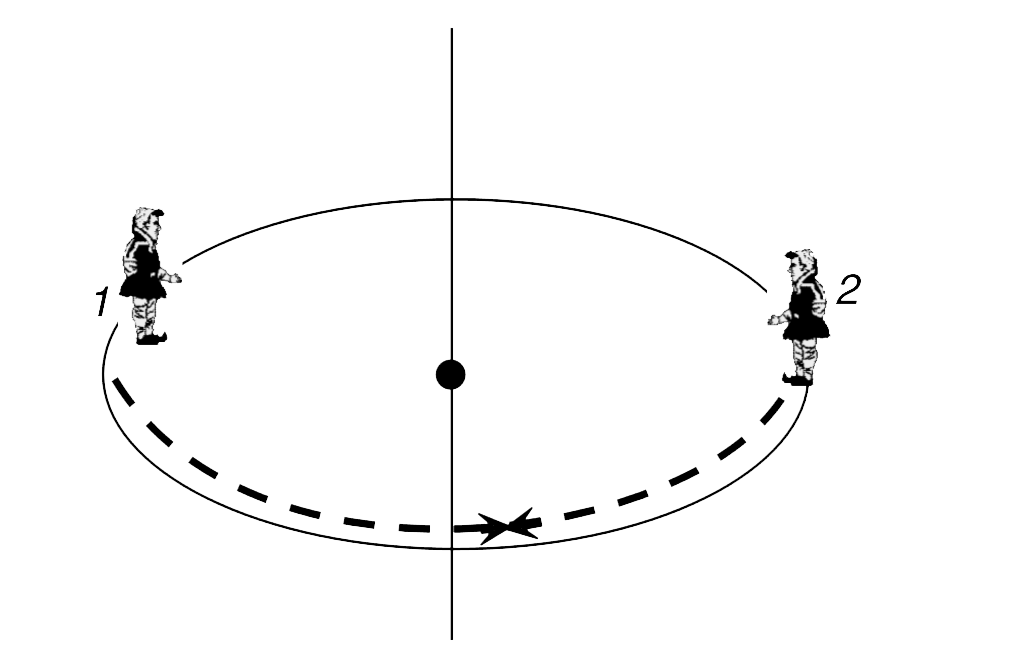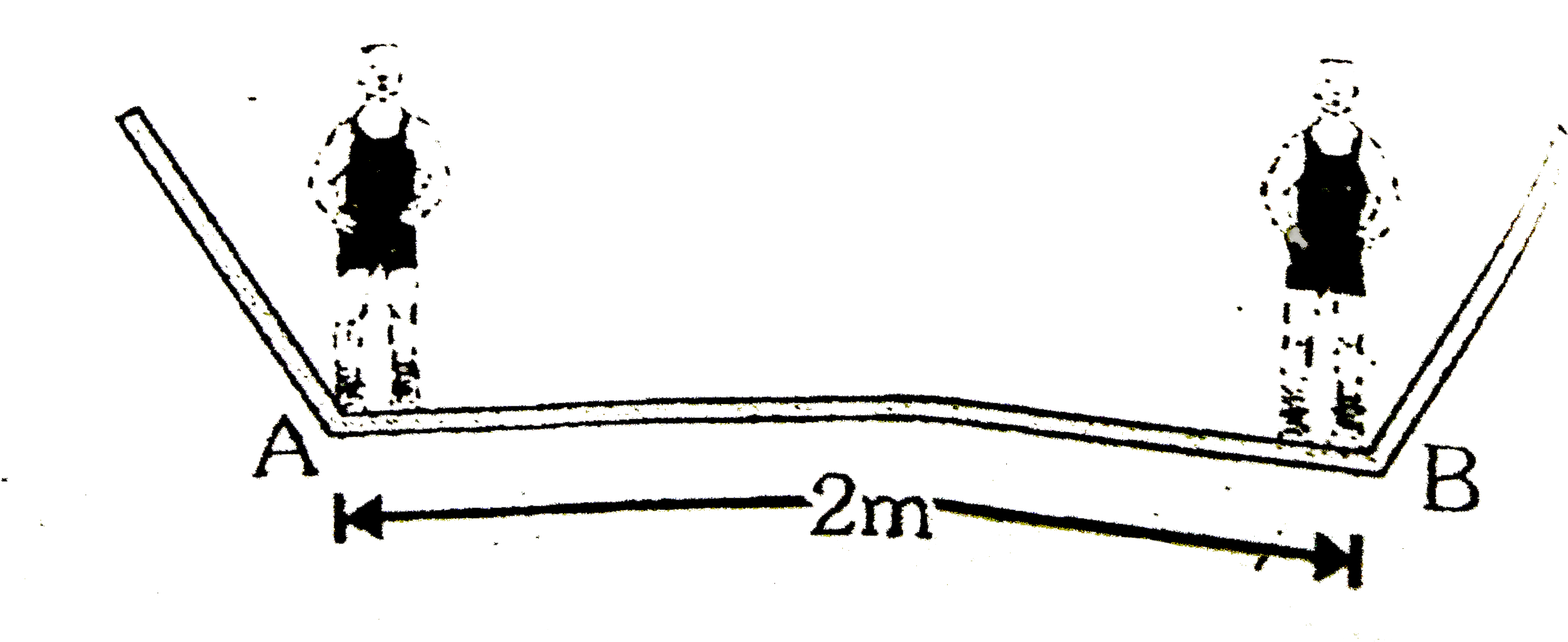Two skaters A and B of mass 50 kg and 70 kg respectively stand facing each other 6 metres apart. They then pull on a light rope stretched between them. How far each moved when they meet?
Both have moved 3 metres.
A moves 2.5 metres and B moves 3.5 metres.
A moves 3.5 metrs and B moves 2.5 metres.
A moves 2 metres and B moves 4 metres.
The correct Answer is:C
To solve the problem of how far each skater moves when they meet, we can use the concept of the center of mass. Here's a step-by-step solution:
Step 1: Identify the masses and initial positions
- Mass of skater A (m_A) = 50 kg
- Mass of skater B (m_B) = 70 kg
- Initial distance between them = 6 meters
Step 2: Calculate the center of mass
The center of mass (CM) of the system can be calculated using the formula:
xCM=mA⋅xA+mB⋅xBmA+mB
Assuming skater A is at position 0 (x_A = 0) and skater B is at position 6 (x_B = 6):
xCM=(50⋅0)+(70⋅6)50+70
xCM=0+420120=420120=3.5 meters
Step 3: Determine how far each skater moves
Since the skaters pull on each other and there are no external forces acting on the system, they will meet at the center of mass.
- Skater A moves from 0 to 3.5 meters:
Distance moved by A=3.5 meters
- Skater B starts at 6 meters and moves to the center of mass:
Distance moved by B=6−3.5=2.5 meters
Step 4: Conclusion
- Skater A moves 3.5 meters.
- Skater B moves 2.5 meters.
Thus, the final answer is:
- A moves 3.5 meters, and B moves 2.5 meters.
- Mass of skater A (m_A) = 50 kg
- Mass of skater B (m_B) = 70 kg
- Initial distance between them = 6 meters
The center of mass (CM) of the system can be calculated using the formula:
xCM=mA⋅xA+mB⋅xBmA+mB
Assuming skater A is at position 0 (x_A = 0) and skater B is at position 6 (x_B = 6):
xCM=(50⋅0)+(70⋅6)50+70
xCM=0+420120=420120=3.5 meters
Since the skaters pull on each other and there are no external forces acting on the system, they will meet at the center of mass.
Distance moved by A=3.5 meters
Distance moved by B=6−3.5=2.5 meters
- Skater A moves 3.5 meters.
- Skater B moves 2.5 meters.
- A moves 3.5 meters, and B moves 2.5 meters.
Topper's Solved these Questions
- LAWS OF MOTION, FRICTION AND ARCHIMEDES' PRINCIPLEBOOK - MCGROW HILL PUBLICATIONCHAPTER - LAWS OF MOTION, FRICTION AND ARCHIMEDES' PRINCIPLEEXERCISE - HIGHER ORDER THINKING QUESTIONS
34 Videos
- HEATING AND MAGNETIC EFFECTS OF CURRENT BOOK - MCGROW HILL PUBLICATIONCHAPTER - HEATING AND MAGNETIC EFFECTS OF CURRENT EXERCISE - HIGHER ORDER THINKING QUESTIONS
34 Videos
- MEASUREMENTBOOK - MCGROW HILL PUBLICATIONCHAPTER - MEASUREMENTEXERCISE - ELEMENTARY QUESTIONS (HIGHER ORDER THINKING QUESTIONS)
13 Videos
Similar Questions
A horizontal turn table of mass 90kg is free to rotate about a vertical axis passing through its centre. Two men –1 and 2 of mass 50kg and 60kg respectively are standing at diametrically opposite point on the table. The two men start moving towards each other with same speed (relative to the table) along the circumference. Find the angle rotated by table by the time the two men meet. Treat the men as point masses.

View SolutionTwo particles A and B of mass 1 kg and 4 kg respectively approach each other due to their mutual gravitational force only. Then the ratio of acceleration of A to B at any instant is
View Solution
Knowledge Check
Which of the following statements is true ?
(i) A car of mass M is tied by one end of a massless rope of length 10m. The other end of the rope is in the hands of a man of mass M. The entire system is on a smooth horizontal surface.The man is at x=0 and the cart at x=10m. If the man pulls the cart by the rope, the man and the cart will meet at the point x=5m.
(ii) Two spherical bodies of mass M and 5M and radii R and 2R, respectively , are released in free space with initial separation between their centers equal to 12R. If they attract each other due to the gravitational force only , then the distance covered by the smaller body just before collision is 7.5R.
(iii) Two skaters A and B , having masses 40kg and 60kg , respectively stand facing each other 10m apart on a horizontal smooth surface. They pull on a rope stretched between them , the distance covered by A, when skaters meet is 6m.
(iv) A ballon (mass M) is attached to light rope of length L. To the other end of the rope a boy (mass m) is hanging in air. The system is at rest. The distance travelled by the balloon (in downward direction) when the boy touches the ballon is MLM+m.A(i),(ii)B(i),(ii),(iii)C(iii),(iv)Dall of the aboveTwo bikers A and B start and ride at 75 km/hr and 60 km/hr respectively towards each other. They meet after 20 minutes. How far (in km) were they from each other when they started ?
A60B45C30D15Two bikers A and B start and ride at 75 km/hr and 60 km/hr respectively towards each other. They meet after 20 minutes. How far (in km) were they from each other when they started ?
A60B45C30D15
Two particles A and B of masses 1 kg and 2 kg respectively are kept 1 m apart and are released to move under mutual attraction. Find The speed A when that of B is 3.6 cm/hr. What is the separation between the particles at this instant?
View SolutionTwo skaters have weight in the ratio 4:5 and are 9m apart, on a smooth frictionless surface. They pull on a rope stretched between them. The ratio of the distance covered by them when they meet each other will be
View SolutionTwo persons A and B of weight 80kg and 50kg respectively are standing at opposite ends of a boat of mass 70kg and length 2m at rest. When they interchange their positions then displacement of the centre of mass of the boat will be :-

View SolutionTwo spheres, each of mass 625 kg, are placed with their centres 50 cm apart. The gravitational force between them is
View SolutionTwo ice-skaters of mass 120 kg and 200 kg are initially hugging on a frictionless ice surface. Ten seconds after they push off from each other, they are 8.0 cm apart. The distance moved by the skater of mass 200 kg is
View Solution
